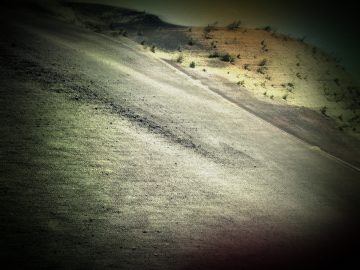by Leanne Ogasawara

Imagine finding out that intelligent life had been discovered in our galaxy. To learn that across the endless ocean of intergalactic space there exists a planet filled with new forms of life –and riches unimagined: this was how it must have felt for the people of the Renaissance, when Christopher Columbus discovered the New World. After all, there was a reason why the people of the time called it the New World, instead of just the new continent. For this was a revelation; not just of new land, but of sought-after minerals, like gold and silver. It was a new world of tastes. From potatoes to tomatoes and chocolate to corn, the dinner tables of Europe would be transformed in the wake of Columbus’ trip. There were animals never seen in Europe, like the turkey and bison. And there were wondrous new plants and flowers. There was even a new shade of red. Made from the female cochineal insect, this new dye became– after gold– the second largest import from the New World.
Perhaps most astonishing were the people. At a time when Europe was itself organizing into nation-states, often under all-powerful monarchs, Columbus found in the Americas, what seemed to his eyes, to be free and egalitarian societies. Not only did the people not use money, but even more remarkable was their lack of private property. Private property was, after all, the bedrock of the new banking system back home.
And theologically, how were the Europeans to explain a population of people who could not be descended from Noah’s three sons; of human beings ignorant of the New Testament for over a thousand years?
It is something that can best be imagined by comparing it to our finding intelligent life beyond the solar system. For like the people of the Renaissance, wouldn’t we be gob smacked by the wonders and riches of an extraterrestrial new world? For now, it remains something beyond imagination. The discovery of exoplanets, recently honored with the Nobel Prize in Physics, has brought it a little bit closer; for in the same way the people of Renaissance debated the possibilities for life in the antipodes, so too does our current search for exoplanets pay particular attention to planets found orbiting stars within what astronomers call the Goldilocks Zone. This habitable zone is conservatively defined as having conditions that would enable liquid water to form. It is conservative because it takes our own carbon-based life, which depends on water, as the model for life everywhere.
 2.
2.
Astrophysicist Neil deGrasse Tyson suggests there are three main drivers that propel nations to do “grand things” (that is, commit large sums of money):
1) War: “There’s always money to fight a war,” he says. Such defense projects have included, the Manhattan Project, the Great Wall of China, the Interstate Highway System (as a means to move military supplies). He also includes the Apollo Project in this category, given its connection to the Cold War with the Soviet Union.
2) In praise of a deity or royalty: Such “religious” projects have included , the Pyramids, Versailles, the Cathedrals.
3) Promise of economic return: He gives as examples Columbus and Lewis and Clark.
He goes on in a talk at the World Government Summit held in Dubai last year to claim that countries no longer commit large sums of money for 2) –and therefore any contemporary impetus for space exploration will be driven by 1) and 3).
He further asserts that the first trillionaires will be from these businesses:
Mining Asteroids
Deflecting Asteroids
Harvesting Water from Comets
Vacation: Moon, Mars, & Beyond
Questions immediately emerge.
Was Columbus motivated strictly by commercial concerns? And more to the point, were his underwriters?
Mexican writer and translator Ilan Stavans in his book, Imagining Columbus, recounts some of the wildly changing incarnations the explorer has occupied in our collective imaginations over the past five hundred years. Stavans contends–and I agree– that only Jesus Christ has been interpreted in so many different ways. In my lifetime, for example, Columbus has gone from “rational man of commerce and science” to the representation of all the evils of imperialism and religious fanaticism. Reading Stavans book, I was surprised by just how many great writers have engaged with Columbus in literary terms– from Nietzsche, Whitman, Umberto Eco and James Fenimore Cooper to Borges, Salman Rushdie, and Kazantzakis.
Stavans himself has been fascinated by the explorer since childhood and helpfully narrows down the multitude of literary tropes into three main types: that of messiah; that of ambitious gold seeker; and that of a conventional, rather unremarkable man.
A bumbler, some said.
I myself had long viewed Columbus as being in the self-appointed messiah category. Off to find a passage east by sailing west–this was the hero’s journey par excellence for medieval Christians. It was also practical; for in the East, they believed, one could grab the gold needed to fund a new crusade. In this way, we can say that both religion and commercial interests motivated Columbus; with Isabel and Ferdinand further motivated by defense in their arms race with Portugal.
Tyson claims that 2) is out of the question. But perhaps he is being premature to so easily dismiss this? Where, for example, does purely curiosity-driven scientific research fall? Sometimes referred to as the “Carl Sagan approach to space,” space entrepreneur Rick Tumlinson has dismissed this as being a non-starter for future manned space projects, since robotics can be used far more cheaply.
So then, is the idea of non-commercial scientific space exploration really a non-starter in today’s world?
I was born the year man landed on the moon. The human space missions lit my imagination on fire when I was young. One could argue that discovery is something that is inherently part of the human condition and that space is just in our blood. That’s what Carl Sagan believed, anyway.
 3.
3.
Traveling into the unknown, Columbus brought with him many images, notions and fantasies, gleaned from the books and maps that made up his inner landscape. In much the same way that we imagine childlike, more evolved, or even terrifyingly cruel extraterrestrials out there in space, some in Columbus’ age imagined that there could be monstrous races thriving in the extreme climates of the tropical zone. Following the ancient philosophy of the humors and climates, they toyed with the idea that warlike people inhabited northern climes. Gentler, childlike races would live in the tropics, perfect for becoming slaves, the ultimate human resource.
And, one could argue, we carry these stereotypes of people in the tropics with us even today.
We moderns–at least in the last hundred years– similarly have a long tradition of imagining various monster races out there in space. Maybe this is the reason that a professor I know over at Caltech ends his undergraduate history class on exploration and imperialism by having the students watch the 2009 movie, Avatar. For all its debatable weaknesses, the movie does show us a future encounter with an extraterrestrial new world, where human beings arrive, not in a spirit of peace, but rather to seize resources and exploit the extraterrestrial population. One side wins, and one side loses in the movie. My professor friend has his students read first-hand accounts of the violent exploitation, since Columbus was condemned even by the people of his own age for inhumane acts.
Not surprisingly, my friend is not optimistic about human space travel.
Perhaps even more interesting than Avatar are two science fiction novels that bring religion into the equation, thereby recalling even more the journeys of Columbus. Mary Doria Russell’s 1996 novel, The Sparrow, begins when mysterious and beautiful radio broadcasts of music originating in the vicinity of Alpha Centauri are detected at the Arecibo Observatory in Puerto Rico in 2019. Before the UN or any large corporation has a chance to do anything, a scientific mission is organized by the Jesuits.
Unlike in Avatar—or Columbus’ journeys for that matter—the Jesuit mission is peaceful and sent for no commercial motivation. Written in the days before climate change dominated the news or the triumph of neoliberal values, it comes almost as a shock to read of an imagined future, where disaster on earth coupled with economic greed is not behind the mission. Reading about this future Jesuit mission in the novel, it was honestly hard for me to wrap my mind around the idea that they didn’t want something commercial. Of course, the crew in The Sparrow—like the 16th century Jesuit Missions to China—was not fleeing an earth falling apart due to ecological disaster. Today, so intertwined has the idea of human space exploration become with that of climate disaster and commercial exploitation, that it was very hard for me to accept the premise of the novel.
Has our world changed so much since the late 90s that a book about space travel that is NOT for commercial exploitation and NOT because our own world on fire is really that hard to believe?
For this reason, Michel Faber’s recent novel The Book of Strange New Things is far more familiar. In Faber’s book, we find an evangelical preacher sent to a distant exoplanet. Hired by a large corporation, he is there to bring the native inhabitants the message of Christ. Recalling Columbus’ voyage, this is ultimately a tale of winners and losers. The losers, however, are not so much the native inhabitants –who have demanded a preacher if the colonizers want to keep receiving food from them—but rather those left behind on earth. Facing a world of climate disaster back home, the preacher learns of the fate of the earth in a series of messages from his wife. The emails grow increasingly desperate concerning our planet’s fast descent into chaos, violence, and wide-spread suffering. And this is what is behind the corporations’ mission on Oasis; for everyone other than the preacher has been contracted to build a safe haven for the ultra-wealthy. When the time comes and the rich have to flee earth, they will be willing to pay enormous sums of money, reasons “the corporation,” to find a new home on this beautiful planet—infrastructure already in place.
An awful thought. And yet so believable.
Probably the most realistic science fiction I have recently read, James S. A. Corey’s Expanse series (the TV series is fantastic!) portrays a future where the earth can no longer support anyone but the super-rich. A faction of settlers re-locates to Mars, where they are in the process of building a new planet—with its own unique culture and values. Both the rich and powerful earthlings and the plucky Martian frontier people exploit those who had to relocate to the asteroid belt, where these “belters” supply the resources required to keep earth and Mars up and running. Again and again, characters rail against the greed of the earthlings—given a perfect blue-green garden world, only to destroy it.
What kind of people would do such a thing? they ask.
 4.
4.
The stars beckon with the rich and the strange; the imagined and the unimaginable. Gone are the days when we debated what is out there across the oceans. There is no more terra incognito. Now, we look out across the galaxy. And like the explorers of old, we imagine what types of worlds might contain resources; and more, which places could be hospitable to intelligent life. What we imagine is bounded by the laws evolution and liquid water. Or maybe even a different kind of liquid. We also like to imagine intelligent life out there….Perhaps someday stepping out onto this far-flung new world, we will gasp with delight and wonder.
And carrying not a message of greed, but the thrill of discovery, is it possible to even imagine that may we be a little more enlightened this time…?
–Thanks to 3QD’s Bill Benzon for help in thinking about the issues in section 2. I began thinking about this after reading The Return of the New Space Visionaries in the New Atlantis (No 56) and to Robert Fay, for pointing me toward the novel The Sparrow (highly recommend it, as well as the sequel, Children of God). And please don’t miss Michel Faber’s The Book of Strange New Things.
My exoplanet pics taken in Craters of the Moon.
Recommended Reading
James S. A. Corey’s Expanse Series (the show is fantastic!)
Carol Delaney’s Columbus and the Quest for Jerusalem: How Religion Drove the Voyages that Led to America
Michel Faber’s novel The Book of Strange New Things
Valerie Irene Jane Flint’s The Imaginative Landscape of Christopher Columbus and THE CATALOGUE OF SHIPWRECKED BOOKS
Christopher Columbus, His Son, and the Quest to Build the World’s Greatest Library
By Edward Wilson-Lee
Donald Goldsmith’s Exoplanets: Hidden Worlds and the Quest for Extraterrestrial Life
Nicolás Wey-Gόmez’s The Tropics of Empire: Why Columbus Sailed South to the Indies
Amy Butler Greenfield’s A Perfect Red: Empire, Espionage, and the Quest for the Color of Desire
Alfred Hiatt’s Terra Incognita: Mapping the Antipodes
Toby Lester’s The Fourth Part of the World: An Astonishing Epic of Global Discovery, Imperial Ambition, and the Birth of America
Ilan Stavans’ Imagining Columbus
Mary Doria Russell’s 1996 novel, The Sparrow
Mary Alexander Watts’ Dante, Columbus and the Prophetic Tradition: Spiritual Imperialism in the Italian Imagination
https://www.youtube.com/watch?v=hRKtBiIhrBM
